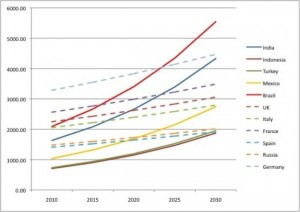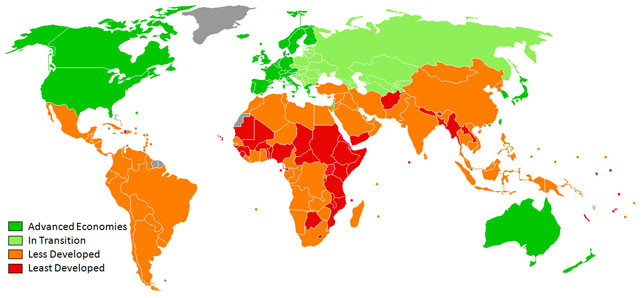Mexico’s Pursuit of “Developed Nation” Status
In an April 24 address to the U.S. Chamber of Commerce, Mexican President Felipe Calderón highlighted the strength of Mexico’s economy, which has experienced an average growth rate of 1.5 percent GDP per capita over the past 20-plus years. As a recent study reveals, this consistent growth has enabled 53 percent of Mexicans to join the ranks of the middle class, a trend substantiated through significant shifts in Mexican society. Notably, Mexico’s fertility rate is now consistent with those observed in developed nations. At a high of 7.1 children per woman in the 1960s, the average fertility rate is now just 2.3 children per woman, as compared to 2.1 children per woman in the United States. Additionally, Mexico’s system of higher education is rapidly expanding. Colleges such as TecMilenio, a private institution offering a relatively affordable education at over 40 satellite campuses across Mexico, are becoming commonplace. According to Negocios, Mexico’s federal business publication, more than 100,000 students graduate from engineering programs in Mexico every year. Finally, infrastructure projects, requiring large amounts of both financial and human capital, are also on the rise in Mexico. Between 2007 and 2011, investment in railway construction reached rates 175 percent higher than those between 2001 and 2005, as did redoubled efforts to modernize harbor facilities.
If economic forecasts and these indicators of growth prove correct, the Mexican economy will continue to experience consistent growth well into the future. According to a recent article published in Foreign Policy, the global community would do well to shift its focus toward the TIMBI nations (Turkey, India, Mexico, Brazil, Indonesia), whose economies are expected to outpace those of the BRICS in short time. Indeed, the Mexican economy is expected to be as large as those of Spain and Russia by 2020, and surpass Italy’s economy by 2030.

While Mexico’s economic outlook is strikingly promising, several impediments still stand in the way of Mexico becoming a first-tier developed nation, including a lack of balance between collective action and business interests, income inequality, security issues, and government corruption.
Balance of Business and Labor
By taking advantage of rampant corruption at the highest levels, Mexican businesses have disenfranchised workers by blocking them from taking part in collective-bargaining sessions. Mexican labor law permits only the union attracting the majority of workers in a given industry to enter into contract negotiations, thus limiting the possibilities of collective bargaining. These regulations allow businesses to undermine unions legally, thus creating an alternative to bribing government officials. Business leaders find it far easier to infiltrate unions and use them for their own purposes than to allow them to function properly.
Exemplary of the extent to which collective bargaining has been degraded, Johnson Controls Inc., a multinational with a reputation for corporate responsibility, failed to distribute 10 percent of its profits to workers, which is required by Mexican law. While an independent labor union was able to step in on behalf of the workers in this case, securing a promise of increased wages, school aid payments, and greater insurance coverage, calls for such intervention are often unmet. Furthermore, in response to the strike, Johnson Controls Inc. relocated its Puebla factory to a region where its employees were unable to seek union protections, subverting the substantive and symbolic progress made against the employer.
Mexico’s labor law is in clear need of reform. Rather than pandering to the upper echelons of the business community, lawmakers should be pressed to consider the interests of independent unions. While Mexican law regarding unionization is often cited as antiquated and ineffective, attempts to enact reform, such as President Calderón’s federally mandated minimum wage and 40-hour workweek, have been stymied by politicking within Mexico’s bicameral legislature. Future administrations confronting labor reform would do well to focus on eliminating the legislation allowing only a single union to represent the interests of an entire industry. If this provision is altered, Mexico’s businesses will undoubtedly attain a more balanced and equable relationship with the country’s labor force.

However, policymakers are cautioned to consider the implications of such reforms for the labor-business balance as it applies to the country as a whole. According to The Economist, Mexico’s teachers union, composed of 1.2 million members, is the most powerful union in the country and has been cited as a determinate political force. Critics say the union is to blame for Mexico’s dysfunctional educational system, a casualty of hard-fought and expensive legal battles that have been staged to protect out-of-touch, ineffective teachers. It is imperative that Mexican policymakers develop a system of laws and regulations capable of balancing the interests of both workers and the general public in order to achieve a robust modernization of the country’s economy.
Dysfunctional Public Education
Mexico’s education system, which consistently receives low ratings by international indicators, must also endure reforms. According to a Reuters report by Anahi Rama, 5 percent of Mexico’s GDP goes to education. While this allocation is proportional to those made by other developing countries, corruption renders much of this input largely ineffective. The Organization for Economic Cooperation and Development (OECD), in comparing education across 65 industrialized countries, ranked Mexico 46th in reading, 49th in mathematics, and 51st in science. While 10 percent of U.S. students are able to complete the advanced math section of the OECD’s International Student Assessment exam, only 0.07 percent of Mexican students are able to do the same. Aside from low scores, graduation rates in Mexico pale in comparison to those in the United States. According to Reuters, Mexican public schools graduate only about 45 percent of secondary school students, while nearly 75 percent of U.S. high school students graduate. Although Mexico’s constitution guarantees access to education for all citizens, it hardly guarantees quality. A skilled labor force is imperative to sustain Mexico’s economic growth, and while post-secondary education in Mexico looks to be on the rise, primary and secondary education still requires vast improvements. If Mexico is to secure a large, skilled labor force, salvaging public education will prove an essential policy initiative within the coming years.
Income Inequality
Currently, Mexico’s income inequality is among the worst in the world. According to an OECD report published in 2008, Mexico ranks second in economic inequality among the 34 OECD nations, experiencing a level of disparity slightly less than that of Chile. The average income of the wealthiest 10 percent of Mexicans was around 26 times higher than the average income of the poorest 10 percent of Mexicans. Moreover, what is considered “middle class” in Mexico is certainly not comparable to the middle class in the United States, as Mexico’s middle class receives relatively low wages. For example, as noted by the Washington Post, Mexicans working for U.S. auto companies earn about 10 percent of what their American counterparts make.
Adding to the gap in income distribution is the propensity of top income earners to monopolize the economy; 40 percent of Mexican businesses remain “uncompetitive,” ultimately antithetical to the functioning of a market economy. For example, Tellcell, the telecommunications conglomerate owned by the world’s richest man, Carlos Slim, now finds itself in a legal battle after facing anti-trust allegations, a common feature of Mexican business environment.

Security
In light of persistent cartel violence, security arguably remains the most important concern for the majority of Mexicans. Mexico has been entirely unsuccessful at controlling violence within its borders, failing repeatedly to combat the cartels. The drug-related death toll, which has climbed above 50,000 since 2006, can be ascribed to the decision to militarize efforts to combat the drug cartels, made by former President Vicente Fox and sustained by Calderón’s administration. The militarization of Mexican security efforts has also resulted in mounting human rights violations. According to the National Human Rights Commission (CNDH), the number of complaints against the military has mounted dramatically, from 182 in 2006 to 1,230 in 2008, of which only 37 have seen daylight in the justice system. Underlying problems include the immense financial resources the drug cartels are capable of consigning to the struggle (estimated to be between USD 30 billion and 50 billion), lack of alternative employment, and the ineffective collaboration between Mexican and American drug policy. Regional heads of state have argued for alternative drug policies, such as decriminalization, even if they may not align with Washington’s heavy-handed approach to the drug trade. Latin American nations recently demonstrated increased solidarity in pushing alternative policy solutions at the Sixth Summit of the Americas. Whether they be less militarized approaches to combating the drug trade or decriminalization, Mexico needs to heed the advice of its neighbors and remedy its failing militarized approach.
Corruption
Likewise, Mexico needs to address its failure to uphold the rule of law, as widespread corruption still prevails in many sectors of public life, including the police force and gubernatorial offices. In Mexico, government and corruption seem to be synonymous. Transparency International’s Bribe Payers Index concluded that, in 2010, an estimated USD 2.5 billion in bribes were paid to police officials throughout Mexico. Importantly, the chain of corruption does not end at the local level. Julio César Godoy Toscano, a congressman with ties to the notorious La Familia cartel, was caught with USD 2 million in his bank account from “unknown sources.”
As previously mentioned, Mexican businesses also participate in rampant corruption, not only to co-opt labor unions but also to influence public figures. In a Transparency International study analyzing 28 economies in which firms were most likely to bribe officials, Mexico ranked third behind China and Russia. Few were surprised when Wal-Mart was accused of bribing local officials to win land contracts and gain permission to open stores early. Although the Calderón administration has made some efforts to fight corruption, they have proved insufficient, and the lack of transparency and accountability plaguing Mexican governance requires considerable redress.
Conclusion
As Mexico marches down the road to developed-nation status, several factors will critically hinder Mexico’s progress unless promptly addressed. Rather than focusing solely on improving traditional economic indicators, such as GDP, Mexico’s government should pursue policies that will provide a foundation for more equitable, transparent, and sustainable economic development.
Please accept this article as a free contribution from COHA, but if re-posting, please afford authorial and institutional attribution.
Exclusive rights can be negotiated.


